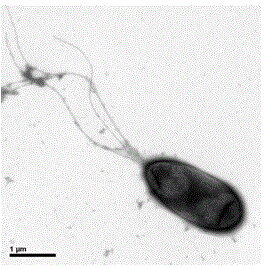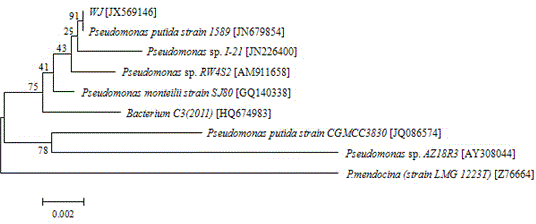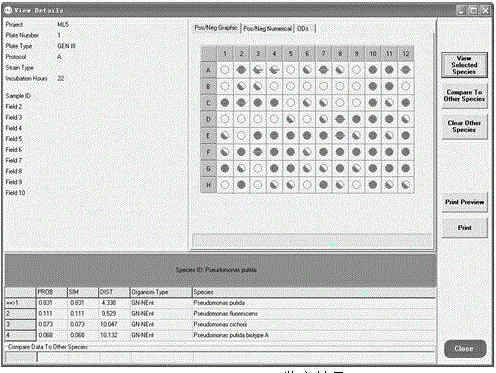Pseudomonas putida having n-hexylene degradation capacity and application thereof
A technology of Pseudomonas putida and n-hexene, which is applied in the direction of bacteria, microbe-based methods, water/sludge/sewage treatment, etc., can solve the problem of Pseudomonas putida application not found, and achieve good engineering application value , the effect of adapting to a wide range of environments
- Summary
- Abstract
- Description
- Claims
- Application Information
AI Technical Summary
Problems solved by technology
Method used
Image
Examples
Embodiment 1
[0019] Example 1: Pseudomonas putida Isolation, purification and identification of WJ.
[0020] 1. Pseudomonas putida Isolation and purification of WJ.
[0021] Pseudomonas putida WJ is a Gram-negative bacterium domesticated and isolated from the activated sludge in the aerobic aeration tank of a factory in Linjiang Industrial Park, Hangzhou. Specific steps are as follows.
[0022] Place the activated sludge in the aeration tank in a 5L brown jar, air-air for a week to remove residual organic matter in the sludge, and then regularly add a small amount of n-hexene liquid as the only carbon source for directional domestication and continue aeration for several days After one week, configure inorganic salt (MM) medium (g·L -1 ): KH 2 PO 4 0.376,K 2 HPO 4 ·3H 2 O 0.456, (NH 4 ) 2 SO 4 0.484, NaNO 3 0.68, Mg(NO 3 ) 2 0.256, CaCl 2 0.011, trace elements (MnCl 2 ·H 2 O 0.06, ZnCl 2 0.088, KI 0.01, NaMoO 4 2H 2 O 0.1, H 3 BO 3 0.05), 1000 mL of disti...
Embodiment 2
[0030] Embodiment 2: pair under different environmental factors Pseudomonas putida Effect and optimization of WJ n-hexene degradation efficiency.
[0031] Investigate the influence of factors such as culture solution pH and culture temperature on the degradation effect of n-hexene, the specific implementation results are as follows:
[0032] After culturing at different temperatures for 20 h, the residual n-hexene and biomass ( Figure 5a ). The results showed that the degradation efficiency and biomass production (mg·L) of the strain WJ at different temperatures -1 ) had obvious differences, and the biomass and degradation efficiency gradually increased with the increase of temperature, but when the temperature was higher than a certain value (30°C), the degradation rate and biomass decreased instead. This is because the degradation process of microorganisms is generally an enzymatic reaction. When the temperature is low, the strain grows slowly and has poor metabolic act...
Embodiment 3
[0035] Example 3: Pseudomonas putida WJ analysis of the degradation performance of different concentrations of n-hexene.
[0036] Under the best environmental factors culture conditions (culture medium Ph 7.0, culture temperature 30°C), the strains were investigated Pseudomonas putida Degradation performance of WJ to n-hexene with initial concentration of 25~2000mg / L. The results showed that the strain Pseudomonas putida WJ can completely degrade 25~1500 mg / L n-hexene, but only partially degrade the initial concentration of 2000 mg / L n-hexene. The specific implementation results are as follows.
[0037] Under optimal growth conditions, investigate strains Pseudomonas putida The degradation performance of WJ to different initial concentrations of n-hexene ( Image 6 ), the results showed that the strain WJ could completely degrade the concentration lower than 1500 mg·L -1 n-hexene, and within this range, with the increase of the concentration, the degradation adaptati...
PUM
 Login to View More
Login to View More Abstract
Description
Claims
Application Information
 Login to View More
Login to View More - R&D
- Intellectual Property
- Life Sciences
- Materials
- Tech Scout
- Unparalleled Data Quality
- Higher Quality Content
- 60% Fewer Hallucinations
Browse by: Latest US Patents, China's latest patents, Technical Efficacy Thesaurus, Application Domain, Technology Topic, Popular Technical Reports.
© 2025 PatSnap. All rights reserved.Legal|Privacy policy|Modern Slavery Act Transparency Statement|Sitemap|About US| Contact US: help@patsnap.com



